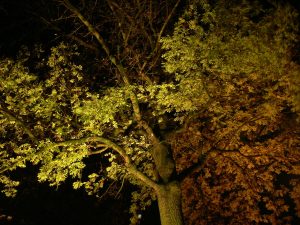 Figure 1. Light pollution and falling leaves: although the photograph was taken in late autumn, this tree has kept the leaves of the lower branches lit by a single light source embedded in the ground. The leaves on the upper branches, i.e. further away from the light source, have fallen off. Photograph taken at Square Dutilleul, Lille. [Source © Lamiot (CC BY-SA 3.0), via Wikimedia Commons].Plants, like animals, are sensitive to light, its colour, intensity and duration of exposure. Thus, blue and red lights of high intensity are required for photosynthesis (link to article “Light on photosynthesis”). Low-intensity red and infrared lights regulate biological rhythms and control processes such as seed germination, stem elongation, leaf expansion, flower development and dormancy. In most cases, the intensity of light pollution is not sufficient to affect photosynthesis. However, by altering the day/night perception of plants and artificially increasing the length of the day, it can inhibit the dormancy of plants that allows them to survive the harsh winter. It can also promote leaf expansion and thus increase plant exposure to air pollution and water stress. In urban areas, it is possible to observe a delay in leaf fall for trees located near streetlights (Figure 1). For example, in New York (USA), leaf fall can be delayed by more than a month compared to surrounding areas [1],[2].
Figure 1. Light pollution and falling leaves: although the photograph was taken in late autumn, this tree has kept the leaves of the lower branches lit by a single light source embedded in the ground. The leaves on the upper branches, i.e. further away from the light source, have fallen off. Photograph taken at Square Dutilleul, Lille. [Source © Lamiot (CC BY-SA 3.0), via Wikimedia Commons].Plants, like animals, are sensitive to light, its colour, intensity and duration of exposure. Thus, blue and red lights of high intensity are required for photosynthesis (link to article “Light on photosynthesis”). Low-intensity red and infrared lights regulate biological rhythms and control processes such as seed germination, stem elongation, leaf expansion, flower development and dormancy. In most cases, the intensity of light pollution is not sufficient to affect photosynthesis. However, by altering the day/night perception of plants and artificially increasing the length of the day, it can inhibit the dormancy of plants that allows them to survive the harsh winter. It can also promote leaf expansion and thus increase plant exposure to air pollution and water stress. In urban areas, it is possible to observe a delay in leaf fall for trees located near streetlights (Figure 1). For example, in New York (USA), leaf fall can be delayed by more than a month compared to surrounding areas [1],[2].
References and notes
[1] Chaney W. (2002) Does Night Lighting HarmTrees? Forestry and Natural Resources, 1-4.
[2] Rich C. & Longcore T. (2006) Ecological consequences of artificial night lighting. Island Press.





